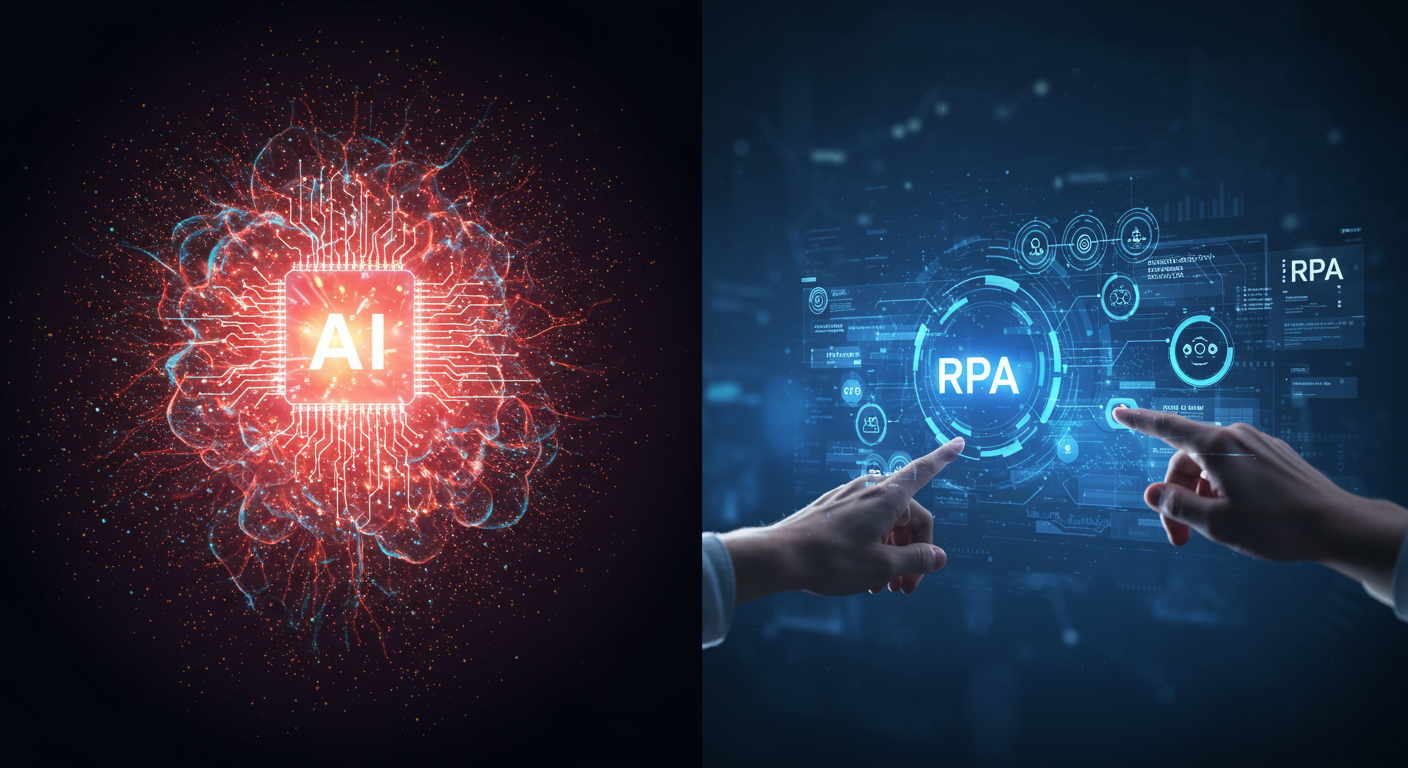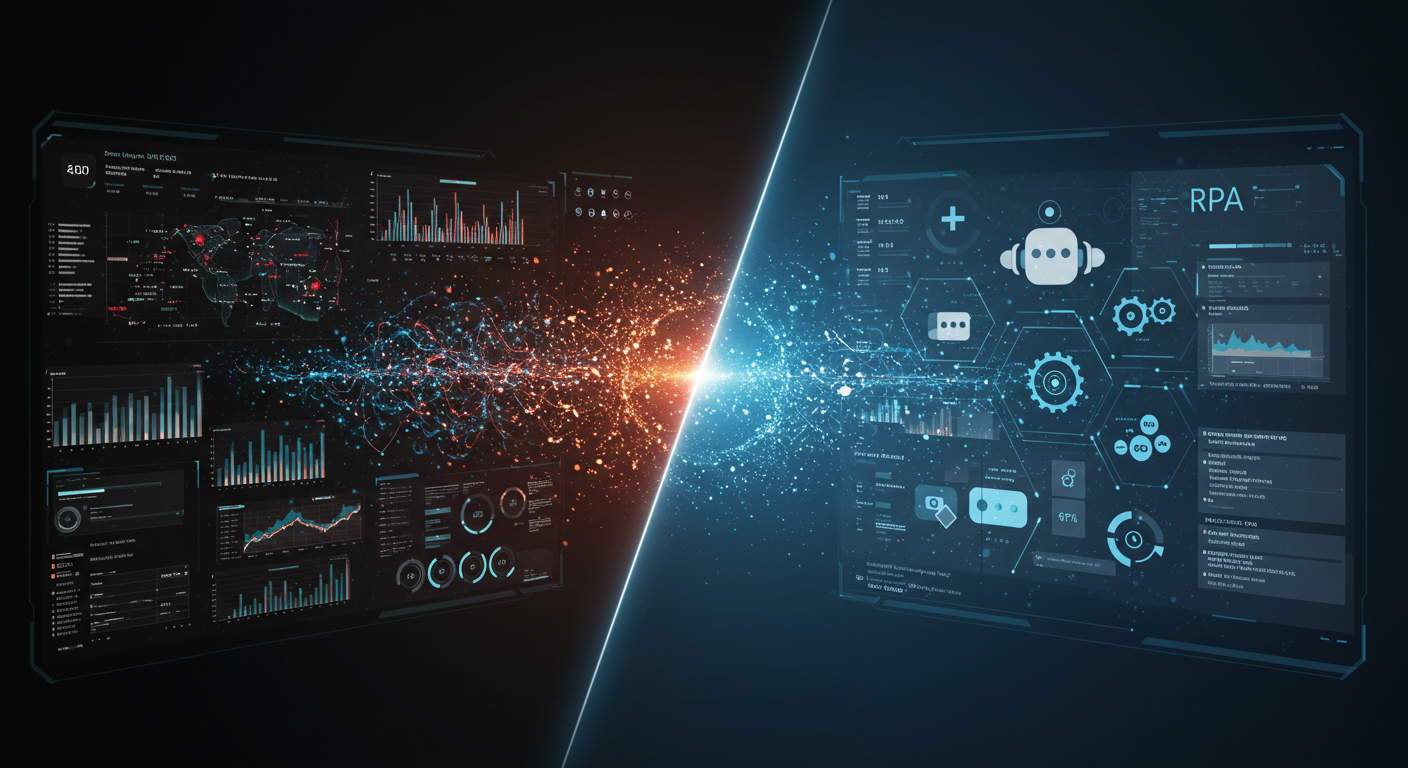Understanding AI and RPA: What Sets Them Apart?
In today’s technology-driven business world, automation has become a key factor in maintaining competitiveness and operational efficiency. Artificial intelligence (AI) and robotic process automation (RPA) are two prominent technologies leading this transformation. While both aim to enhance productivity and reduce manual effort, they function in fundamentally different ways and serve distinct purposes within an organization’s technology ecosystem.
The relationship between AI and RPA is often misunderstood, with many business leaders assuming they’re interchangeable or that one can substitute for the other. This misconception can lead to ineffective implementation strategies and missed opportunities for technological synergy. Understanding the difference between RPA and AI is critical for organizations seeking to maximize their automation potential.
Defining Artificial Intelligence
Artificial Intelligence refers to computer systems designed to perform tasks that typically require human intelligence. These tasks include learning from experience, recognizing patterns, understanding natural language, making decisions, and solving complex problems. AI systems are built to interpret data, draw conclusions, and improve their performance over time without explicit programming for every scenario they encounter. AI technologies encompass several subfields:
- Machine Learning: Systems that learn and improve from experience
- Natural Language Processing: Technology that understands and generates human language
- Computer Vision: Systems that interpret and process visual information
- Expert Systems: Programs that emulate human expertise in specific domains
The power of AI lies in its ability to handle ambiguity and make decisions based on probability and pattern recognition. When properly implemented, AI systems can analyze vast amounts of data to identify trends, predict outcomes, and generate insights that would be impossible for humans to discover manually.
Understanding Robotic Process Automation
Robotic Process Automation, on the other hand, involves software robots or “bots” that mimic human actions to complete rule-based, repetitive tasks across applications and systems. RPA operates at the user interface level, where users click buttons, enter data, copy and paste information, and follow predefined workflows—much like a human would, but with greater speed and accuracy.
Unlike AI, traditional RPA does not learn or make decisions. It follows explicit instructions and executes them precisely as programmed. This makes RPA particularly valuable for:
- Data entry and validation
- Form processing and completion
- Report generation
- System integration where APIs aren’t available
- Legacy system operations
The value of RPA comes from its ability to work across existing systems without requiring significant changes to the underlying infrastructure. It operates on the presentation layer rather than at the database or application level, allowing organizations to automate processes quickly without substantial IT involvement.
Key Distinctions and Applications

Technical Differences Between AI and RPA
The AI and RPA difference becomes clearer when examining their technical foundations. AI uses algorithms and statistical models to learn from data and make predictions or decisions. It requires substantial computing power and large datasets to train models effectively. AI systems are designed to handle variation and can improve their performance over time as they process more information.
RPA, conversely, uses deterministic programming to follow specific rules without deviation. It doesn’t require training data or learning algorithms. RPA bots execute predefined steps exactly as instructed, making them highly reliable for consistent, structured tasks but inflexible when facing unexpected scenarios or process changes.
Another key difference is adaptability. AI systems can adapt to changing conditions and handle exceptions by applying learned patterns, while RPA typically breaks when encountering unexpected scenarios or process changes outside its programming.
From an implementation perspective, AI projects generally involve higher complexity, requiring specialized skills, substantial computing resources, and significant data preparation. RPA implementations are typically less complex and can often be configured by business users with minimal coding. This difference in complexity also affects development timelines, with AI projects usually requiring longer timeframes compared to RPA initiatives.
Industry Applications and Use Cases
Both AI and RPA technologies have found valuable applications across industries, though their use cases differ significantly based on their respective strengths.
AI Applications:
- Healthcare: Diagnostic assistance, treatment recommendations, patient risk prediction
- Finance: Fraud detection, algorithmic trading, credit scoring
- Retail: Customer behavior analysis, inventory management, personalized recommendations
- Manufacturing: Predictive maintenance, quality control, supply chain optimization
RPA Applications:
- Financial Services: Invoice processing, account reconciliation, regulatory reporting
- Healthcare: Patient scheduling, claims processing, data migration between systems
- Human Resources: Employee onboarding, payroll processing, benefits administration
- Customer Service: Order processing, account updates, basic query handling
The relationship between RPA and AI becomes particularly powerful when organizations deploy them in complementary ways. For example, AI might analyze customer communications to determine intent, while RPA handles the subsequent workflow to fulfill the request. This hybrid approach maximizes the strengths of both technologies.
Implementation Considerations
When implementing either technology, organizations should consider several factors:
For AI implementation:
- Data quality and availability
- Ethical implications and bias prevention
- Infrastructure requirements
- Specialized talent needs
- Long-term maintenance and model updating
For RPA implementation:
- Process standardization
- Exception handling
- Change management
- Bot management and scheduling
- Security and access controls
Understanding these requirements helps organizations make informed decisions about which technology best suits their specific needs and how to plan for successful deployment.
Integration and Future Trends

The Power of Combined AI and RPA Solutions
While understanding the difference between RPA and AI is important, recognizing their complementary nature reveals their true potential. Intelligent automation—the integration of AI capabilities into RPA solutions—represents the next evolution in business process automation. In this combined approach:
- AI handles complex decision-making, unstructured data interpretation, and pattern recognition
- RPA manages the execution of resulting actions, interacting with systems and applications
- Together, they create end-to-end automation that can handle both routine tasks and exceptions
For example, in an invoice processing workflow, AI might extract and interpret information from various invoice formats (including handwritten notes), while RPA enters the validated data into financial systems, triggers approval workflows, and schedules payments.
This AI and RPA integration enables organizations to automate more complex processes that were previously considered too judgment-intensive for conventional automation. The emergence of intelligent process automation (IPA) platforms that combine these capabilities is transforming how businesses approach digital transformation.
Cognitive Automation and Intelligent Decision Support
As AI and RPA technologies mature, we’re seeing the rise of cognitive automation—systems that not only execute tasks but also understand context, learn from interactions, and make increasingly sophisticated decisions. These systems can:
- Process natural language in emails and documents
- Analyze images and video content
- Understand sentiment and intent
- Recognize patterns across disparate data sources
- Make recommendations based on historical outcomes
This cognitive capability transforms RPA from a simple task automation tool into an intelligent assistant that can support complex business operations. For instance, in customer service, such systems can analyze incoming queries, categorize issues, retrieve relevant information, and either resolve matters automatically or route them to the appropriate human agent with contextual information.
The AI and RPA difference becomes less distinct in these advanced implementations, as the technologies blend into unified intelligent automation platforms that combine the best aspects of both approaches.
Future Outlook and Strategic Considerations
The future of AI and RPA involves increasingly sophisticated integration and expanded capabilities. Several trends are shaping this evolution:
- Process mining and task discovery: AI-powered analysis to automatically identify automation opportunities and optimize processes
- Low-code/No-code platforms: Democratizing automation development across organizations
- Cloud-based automation: Enabling scalable, accessible automation solutions
- Hyperautomation: Combining multiple technologies (AI, RPA, process mining, etc.) to automate complex end-to-end processes
- Autonomous systems: Self-managing automation that can adapt to changing conditions with minimal human intervention
For organizations navigating this landscape, several strategic considerations are essential:
Building an Automation Strategy
A successful automation strategy requires a clear understanding of both AI and RPA capabilities and limitations. Rather than viewing them as competing technologies, forward-thinking organizations are developing integrated approaches that leverage each for its strengths. This strategy should include:
- Process assessment and prioritization
- Technology selection based on process requirements
- Skills development and organizational readiness
- Governance frameworks for managing automated processes
- Long-term vision for intelligent automation
Measuring Success and ROI
When measuring the success of AI and RPA implementations, it’s important to look beyond just cost savings. Productivity gains are a key indicator—automation should speed up workflows and reduce manual effort across departments. Along with this, improvements in accuracy and quality help reduce errors that could lead to costly mistakes.
Automation also enhances business agility and scalability, making it easier for companies to respond quickly to changes in the market and grow without being held back by manual bottlenecks. Lastly, automation can unlock entirely new capabilities that were not possible before, opening the door to innovation and competitive advantage.
Final Thoughts
The distinction between AI and RPA is significant but increasingly blurred as technologies evolve and converge. Understanding that AI brings intelligence and learning capabilities while RPA delivers reliable execution of defined processes helps organizations deploy these technologies effectively, either independently or in combination.
As businesses continue their digital transformation journeys, recognizing the unique strengths of each technology and how they complement each other will be crucial for building effective automation strategies. The most successful organizations will be those that understand how to apply both AI and RPA appropriately to different business challenges, creating intelligent, adaptable systems that drive operational excellence and competitive advantage.
Organizations can navigate the complex automation landscape more effectively and build solutions that deliver lasting value by focusing on the specific business outcomes they aim to achieve, rather than the technologies themselves. The future belongs not to those who simply adopt these technologies but to those who strategically integrate them into a cohesive automation ecosystem aligned with their business objectives.